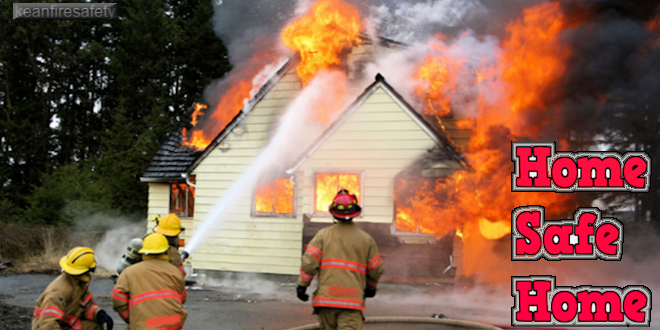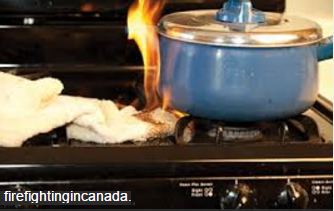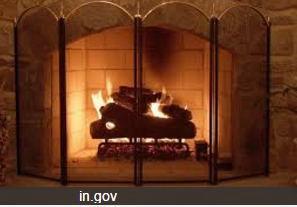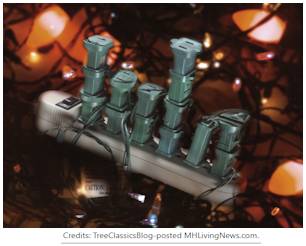‘Tis the Season to Celebrate Fire Safety
in Your New Manufactured Home
“If all pre-HUD-standard manufactured homes were removed from the inventory, the fire death rate per 100,000 occupied manufactured homes would be … well below the range estimated for the rate for other one- or two-family homes.”
— National Fire Prevention Association
“In 2013, Thanksgiving was the peak day for home cooking fires, followed by Christmas Day and Christmas Eve.”
— Liberty Mutual
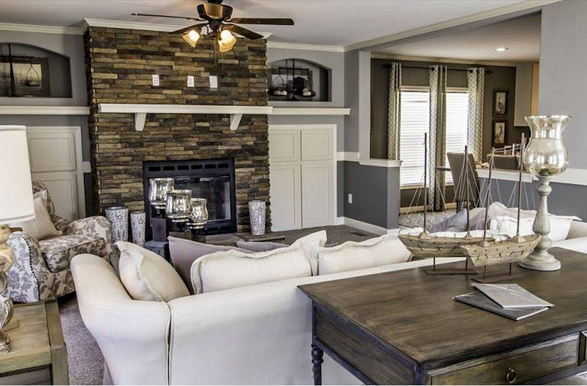
So, you’re finally settled into your new manufactured home, with the fireplace you’ve always wanted, the vaulted ceilings, the spacious kitchen and the open, airy floor plan — all at a price more affordable than you had ever dreamed possible.
You can’t wait to light that fire, host a Thanksgiving feast for friends and family and decorate for the holiday season.
You’ve done your homework and you know that your home has been built to federal standards set forth by the U.S. Department of Housing and Urban Development (HUD).
You know that this home is more energy efficient than the traditional site-built home you used to live in, and that it’s more fireproof as well.
But before you set your inner Norman Rockwell free in your new HUD-code manufactured home, the one factor that you must consider is you — because you are the one cooking and using all kinds of devices that — if misused — can result in catastrophe, no matter how fireproof your home might be.
October is Fire Safety Month — for good reason. The risk of fire rises significantly in fall and winter and fire prevention experts are working overtime to get the word out on special hazards of the season.
As the weather turns cool, more activities move indoors. More heat-related products are in use — from fireplaces and, to generators, heating pads, decorative lights and candles.
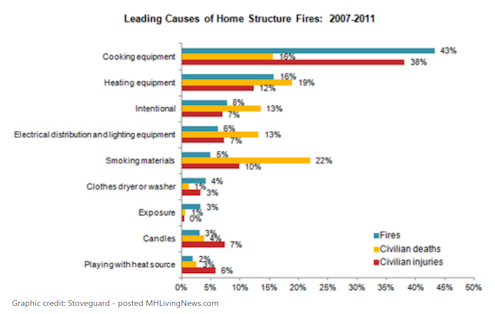
More than 65,000 home fires are attributed to heating equipment alone each year. These fires result in hundreds of deaths, thousands of injuries and millions of dollars in property damage.
Cooking fires are also common during the winter months due largely in part to the holiday season, says the ESFI.
And portable generators are commonly used in the winter as a result of storm-induced power outages — as are candles when the lights go out.
But where there is risk, there is also mitigation. Here is what the experts say everyone should know about fire safety.
According to the National Fire Prevention Association (NFPA):
Cooking fires are the number one cause of home fires and home injuries. The leading cause of fires in the kitchen is unattended cooking.
- Be on alert! If you are sleepy or have consumed alcohol don’t use the stove or stovetop.
- Stay in the kitchen while you are frying, grilling, boiling or broiling food.
- If you are simmering, baking or roasting food, check it regularly, remain in the kitchen while food is cooking, and use a timer to remind you that you are cooking.
- Keep anything that can catch fire — oven mitts, wooden utensils, food packaging, towels or curtains — away from your stovetop.
If you have a cooking fire
- Just get out! When you leave, close the door behind you to help contain the fire.
- Call 9-1-1 or the local emergency number after you leave.
- If you try to fight the fire, be sure others are getting out and you have a clear way out.
- Keep a lid nearby when you’re cooking to smother small grease fires. Smother the fire by sliding the lid over the pan and turn off the stovetop. Leave the pan covered until it is completely cooled.
- For an oven fire, turn off the heat and keep the door closed.
Safety considerations for cooking with oil
Oil is a key ingredient found in the majority of today’s kitchens. Whether a recipe calls for frying or sautéing, we include oil in almost all of our daily cooking. When using any of the many oils to prepare your meals like olive, canola, corn or soybean, consider the following safety tips when cooking:
- Always stay in the kitchen when frying on the stovetop.
- Keep an eye on what you fry. If you see wisps of smoke or the oil smells, immediately turn off the burner and/or carefully remove the pan from the burner. Smoke is a danger sign that the oil is too hot.
- Heat the oil slowly to the temperature you need for frying or sautéing.
- Add food gently to the pot or pan so the oil does not splatter.
- Always cook with a lid beside your pan. If you have a fire, slide the lid over the pan and turn off the burner. Do not remove the cover because the fire could start again. Let the pan cool for a long time. Never throw water or use a fire extinguisher on a grease fire.
- If the fire does not go out or you don’t feel comfortable sliding a lid over the pan, get everyone out of your home. Call the fire department from outside.
Holiday cooking
In 2013, Thanksgiving was the peak day for home cooking fires, followed by Christmas Day and Christmas Eve.
| Date | Fires | Percent above average number of fires per day |
||
| November 28 (Thanksgiving) | 1,550 | (230%) | ||
| December 25(Christmas) | 740 | (58%) | ||
| December 24 (Christmas Eve) | 720 | (54%) |
Source: Liberty Mutual

- Forty-Two percent of surveyed consumers say they have left the kitchen to talk or text on the phone, and 35 percent to use the computer to check email while food is cooking. If you tend to do a lot of cooking, invest in a second or third timer. They’re an inexpensive way to stay safe while ensuring that your holiday dishes do not overcook.
- Nearly half (45 percent) of consumers say they have left the room to watch television or listen to music. Multi-tasking during the busy holiday season is tempting. If you succumb, it’s important not to leave the stove or oven unattended
- Nearly one third (29 percent) of consumers reported that they have intentionally disabled smoke alarms while cooking.
- More than half (56 percent) of surveyed consumers said they plan to cook for family or friends during the holidays this year – with 42 percent of those cooking for groups of 11 or more.
Survey Source: Liberty Mutual Insurance, 2013. Ketchum Global Research & Analytics designed and analyzed this nationwide phone survey (with 35 percent cell sample) of 1,005 adults ages 18-65+. ORC International fielded the survey from October 10-13, 2013, and the survey has a margin of error of +/- 3.1 percent.
Heating equipment is the second leading cause of home fires in the United States, and the leading cause of home fire deaths.
- Keep anything that can burn at least three feet away from heating equipment, like the furnace, fireplace, wood stove, or portable space heater.
- Have a three-foot “kid-free zone” around open fires and space heaters.
- Never use your oven to heat your home.
- Have a qualified professional install stationary space heating equipment, water heaters or central heating equipment according to the local codes and manufacturer’s instructions.
- Have heating equipment and chimneys cleaned and inspected every year by a qualified professional.
- Remember to turn portable heaters off when leaving the room or going to bed.
- Always use the right kind of fuel, specified by the manufacturer, for fuel burning space heaters.
- Make sure the fireplace has a sturdy screen to stop sparks from flying into the room. Ashes should be cool before putting them in a metal container. Keep the container a safe distance away from your home.
Heating pads and electric blankets cause almost 500 fires each year. Almost all of these fires involve electric blankets that are more than ten years old.
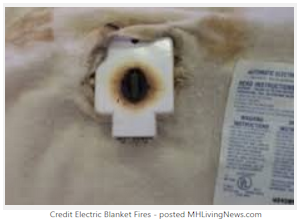
There are two types of personal heating appliances, heating pads that are placed directly on the mattress and electric blankets. They are not meant to be used interchangeably or at the same time.
- Look for dark, charred, or frayed spots or one where the electric cord is cracked or frayed. Replace any worn or old heating pad or electric blanket.
- Do not allow anything on top of a heating pad or electric blanket when it is in use. When covered by anything, including other blankets or pets, electric blankets may overheat.
- Never fold electric blankets when in use. Folded or tucked in blankets could overheat and cause a fire.
- Heating appliances should never be left unattended or used while sleeping.
- Make sure electric blankets are in good repair and certified by an independent testing lab such as UL, CSA or ETL. Power cords should not be frayed, cracked or cut.
- Do not tuck your electric blanket under mattresses or children, and do not put anything, such as comforters or bedspreads, on top of the blanket while it is in use.
- Never allow pets to sleep on an electric blanket.
Holiday celebrations and decorations place a greater burden on electrical components and require greater vigilance, according to the Electrical Safety Foundation International (ESFI).
- Learn where your home’s electrical panel is and which breaker applies to which outlet. There may come a time when you need to flip one of these switches to cut the power to a certain outlet or room so that you can undertake a project safely.
- Avoid overloading your electrical outlets. Make sure each major appliance has its own outlet and avoid plugging more than two smaller appliances into one outlet. Watch for signs of overload such as flickering lights, blown fuses or tripped circuit breakers.
- Practice extension cord safety. Don’t run an extension cord under a carpet or rug or through a wall, as any of these actions could lead to a fire. Remember, extension cords are designed for temporary, not long-term, use.
- Also check for cords that are damaged, pinched by furniture or other objects, stapled or nailed to anything or coiled while in use. And make sure that the cords of kitchen appliances are a safe distance away from hot surfaces.
- Avoid counterfeit, uncertified electrical products at all costs. Find out how to spot a counterfeit product (http://www.esfi.org/resource/not-all-impostors-are-easy-to-spot-537).
So, proud manufactured homeowner, go ahead and string those lights, light that fire and throw out the space heater (you won’t need it in your energy efficient HUD-code home).
For more information about the safety features built into the HUD code and comparisons to fire safety for conventional housing, see “Keeping the Home Fires Burning” here. ##
(Image credits are as shown above)

Submitted by L. A. “Tony” Kovach.
 manufacturedhomelivingnews.com Manufactured Home Living News
manufacturedhomelivingnews.com Manufactured Home Living News
